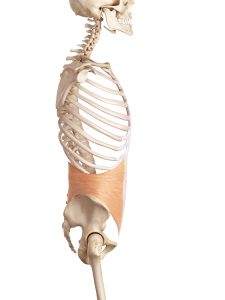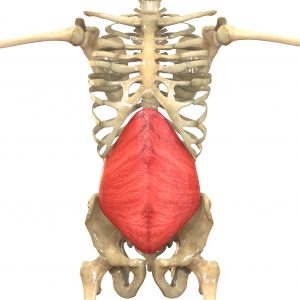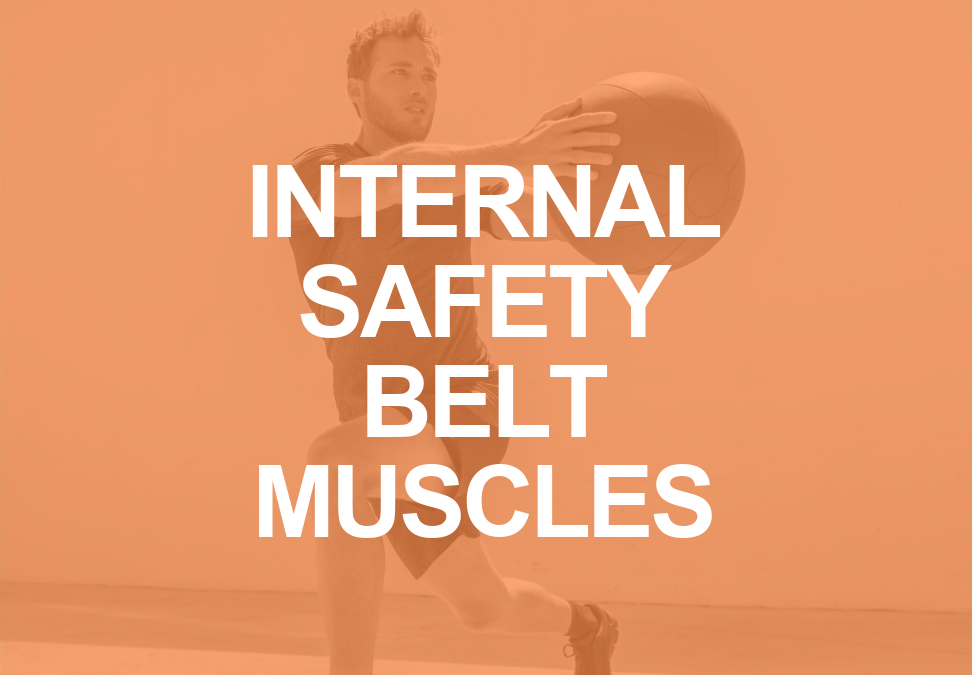Although Rectus Abdominus (RA) muscles are sought for aesthetic and athletic appeal, they do not reign supreme when it comes to core stability and strength. RA by definition are superficial muscles operating as global movers, and are indeed subordinate to two “out of sight” muscles with regard to safety and performance factors. Bordering RA Abdominals are deep core or “internal safety belt” muscles that critically provide proper movements of the human torso, spine, and hips in all three planes of motion: Transverse Abdominis and Internal Obliques.

With client safety in mind, professional trainers should encourage clients to buckle up their “out of sight, out of mind” deep core safety belts.
Trainers should then suggest regular pre-exercise and tailored exercises to help them:
- avoid or minimize lower back pain, or LBP.
- Address muscle imbalances: “It is important to assess muscle imbalances; a short muscle will only increase in range of motion if its antagonist is adequately activated and strengthened.”
- A tight posterior can be remediated with a strong frontal core.
- improve spinal stability
- improve complex hip movements such as walking
- minimize chances of lateral strains
- causes include: overstretching, overuse, improper technique in sports, and even coughing, sneezing, or laughing.
- improve three-plane athletic performance.
This article describes the location and orientation of two “deep core” muscle groups called the Internal Obliques (IO) and the Transverse Abdominus (TVA).


Credits for TVA Images: Shutterstock

Books of Discovery 2014
Important roles of these IO and TVA muscles are cited. Proper ways to activate and use these muscle groups are outlined. Remarks about the benefits of strong IO and TVA corsets underscore the importance of deep core strength. Finally, a subset of key TVA and IO exercises are offered.
Location and Orientation of the Safety Belt
Both Internal Oblique (IO) and Transverse Abdominus (TVA) muscles adjoin the frontal Rectus Abdominis (RA), the IOs, and TVA are layered underneath the lateral/ distal External Obliques. By name, the IO muscle fibers slant diagonally upward and inward from hip to rib cage. And by name, the TVA fibers are horizontal [transverse] belts around torsos or mid-sections between hips and rib cage.
Roles
Trainers should keep in mind the importance of these “safety belt” deep core muscles in athletics and daily life. Why?
- They serve as spine stabilizers.
- They wrap the front of our internal organs to hold them in place from the rib cage to each iliac crest.
- They distend to accommodate changes in our abdomen’s content.
- They support proper “stomach” breathing that is superior to shallow chest breathing in aerobic activity.
- They help the body balance in its complex movements that involve frontal, sagittal, and transverse body planes.
In order to reap these benefits, this pair of Deep Core muscles should be activated and consistently engaged.
Activating Deep Core Muscles
One activator for one’s safety belt wrappers is isometric “hollowing.”
Imagine that the belly button is pulled in toward the spine, c. That isometric effort is “hollowing“. This inward compression of the abdomen region should be held for about 8 seconds or more. The client should feel a lengthening of the spine during this skeletal muscle exercise.
-
- A client can lie down supine, then gently push the fingers of both hands to the side of the navel to feel the important hollowing effect as the client is instructed to pull the naval away from the waistband.
A second key activation scheme is abdominal bracing such as performed during the Pallof Press. Imagine tightening one’s abdomen as if preparing to receive a punch or a body blow pushing outwards in all directions (not just forward). This anti-rotation isometric effort is vital bracing that should be done before a hip hinge, deadlift, kettlebell swing, or similar strength activities.
The importance of hollowing and bracing is hard to overstate!
Key TVA and IO Exercises
While an efficient, strong core is involved in countless compound exercises, a few TVA and IO-focused deep core exercises are important to include in tailored client fitness programs.
- Side Plank with STAR extension
- Russian Twist
- Dead Bug / Tin Soldier Rotations
- Boat Pose (Paripurna navasana)
Yoga and Pilates program exercises are also acknowledged as fine Safety Belt enablers.
- One Yoga Example is the Triangle Pose (Trikonasana).
- One of many Pilates exercises to build and strengthen a client’s Deep Core is the 3-Legged Plank with Leg Pulse.
Summary
Clients should embrace the importance of the safety belt in more ways than safe driving! They should fasten up two Deep Core muscle groups – TVAs and IOs – as critical enables for “painless” activities of daily life. And they must strengthen these Deep Core muscle groups to support safe resistance training.
Dave Frost has served the fitness community as a NFPT-certified CPT since 2013, and a Master Fitness Trainer since 2019.
As a Medicare-aged baby boomer, he specializes in training those clients who intend to stay “well past forty”.
He is a former world champion in Masters Rowing and National Indoor Rowing champion for his age group. He is also a group fitness instructor for The Row House. His website is https://wellpastforty.com. Dave recently published his work: KABOOMER: Thriving and Striving into your Nineties to promote stamininety for those intending to add years to their lives and life to their years.


